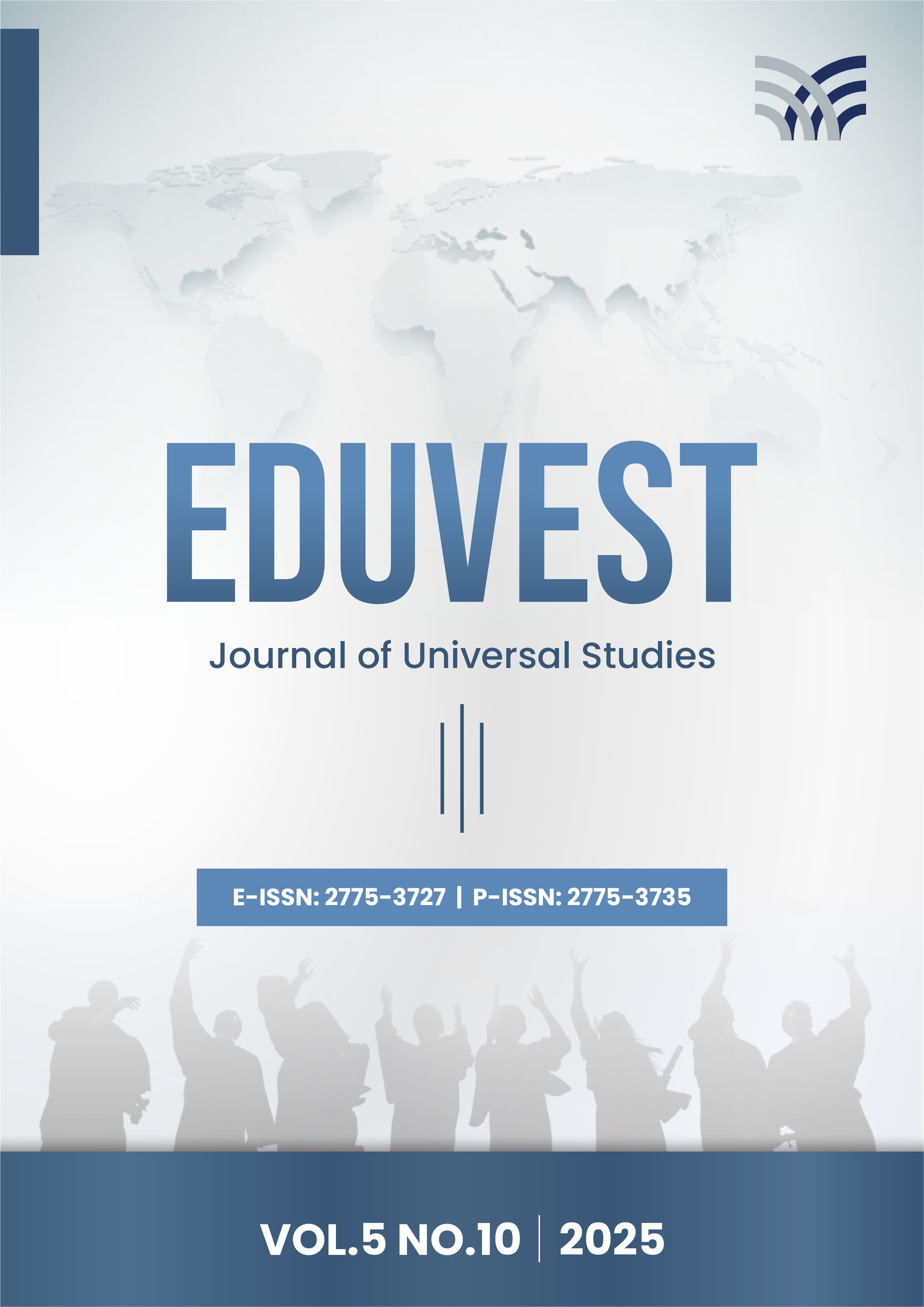Design of Inventory Information System Model on Smart Warehouse Management System (WMS) Based on Artificial Intelligence (AI) with Integration of Waterfall Method and Design Thinking to Optimize Inventory Accuracy
DOI:
https://doi.org/10.59188/eduvest.v5i10.51297Keywords:
Inventory Management, Warehouse Management System (WMS), Artificial Intelligence (AI), Waterfall Method, Design Thinking, Operational Efficiency, Inventory AccuracyAbstract
Modern warehouse operations face significant challenges with manual inventory management processes, resulting in accuracy rates as low as 65% and substantial operational inefficiencies that directly impact customer satisfaction and profitability. This study presents the design and implementation of an innovative Inventory Information System Model for Smart Warehouse Management Systems (WMS) based on Artificial Intelligence technology, specifically developed to address these critical inventory management deficiencies. The research objectives focus on developing an automated system that minimizes human errors, provides real-time data analytics, and enhances overall operational efficiency through intelligent decision-making capabilities. The methodology integrates the structured Waterfall development approach with user-centered Design Thinking principles, ensuring both systematic development and optimal user experience. The AI-powered system incorporates machine learning algorithms for demand forecasting, computer vision for automated stock counting, natural language processing through integrated chatbots for enhanced user interaction, and predictive analytics for optimized inventory levels. Implementation and testing within the Geoff Max Group demonstrated significant improvements, achieving 95% inventory accuracy compared to the previous 70% manual accuracy rate, reducing stock-out incidents by 60%, and decreasing inventory carrying costs by 25%. The system successfully processes real-time data from multiple warehouse locations, providing managers with comprehensive dashboards and automated alerts for critical inventory thresholds. The implications of this research extend beyond operational improvements, offering a scalable solution for modern supply chain management that can be adapted across various industries. This integrated approach represents a significant advancement in warehouse automation, demonstrating how AI-driven systems can transform traditional inventory management practices while providing economic benefits.
References
Aji, S., & Pratmanto, D. (2021). Sistem informasi inventory barang menggunakan metode waterfall. Indonesian Journal of Software Engineering, 7(1), 93-99. https://doi.org/10.31294/ijse.v7i1.10601
Arianto, R., Al Anam, A. K., Devi, B., & Rachman, A. (2021). Pengembangan aplikasi sistem informasi inventory pada CV Wijaya Las Kediri menggunakan model waterfall. Jurnal SAINTIKOM, 20(2), 73. https://doi.org/10.53513/jis.v20i2.3749
Binyu et al. (2024). Impact of warehouse expansion on ambient PM2.5 and elemental carbon levels in Southern California's disadvantaged communities: A two-decade analysis. GeoHealth, 8(9), 1-14. https://doi.org/10.1029/2024GH001091
Erstiawan, M. S., & Alifianto, A. Y. (2021). Pemanfaatan Google Spreadsheet penjualan pada Warung Majapahit di Mojokerto. Ekobis Abdimas: Jurnal Pengabdian Masyarakat, 2(2), 50-57. https://doi.org/10.36456/ekobisabdimas.2.2.4852
Fahrudin, R., & Ilyasa, R. (2021). Perancangan aplikasi 'Nugas' menggunakan metode design thinking dan agile development. Jurnal Ilmiah Teknologi Informasi Terapan, 8(1), 35-44. https://doi.org/10.33197/jitter.vol8.iss1.2021.714
Haryanto, Y. N., & Ariyani, W. (2023). Pengelolaan pengiriman barang komputerisasi di CV Multi Casa Semarang: Analisis akurasi stok. Jurnal Ilmiah Akuntansi dan Bisnis, 3(1), 48-55. https://journal.politeknik-pratama.ac.id/index.php/JIAB/article/view/375
Ma'sum, U., Rahmawati, D., & Muryanah, S. (2023). Rancang bangun sistem informasi e-gudang pada PT.XYZ berbasis website dengan framework Laravel. Jurnal Ilmiah Fakultas Teknik, 3(1), 51-61. https://doi.org/10.33592/jimtek.v3i1.3793
Nurfajrianti, M., & Widharto, Y. (2016). Evaluasi pengendalian persediaan di PT XYZ. Prosiding Seminar Nasional XI "Rekayasa Teknologi Industri dan Informasi", 334-337. https://journal.itny.ac.id/index.php/ReTII/article/view/476
Purba, M. (2024). Sistem inventarisasi stok barang dan penjualan suku cadang. Jurnal Teknologi Informasi, 7, 12-16.
Purwasih, R., & Mittra Candana, D. (2024). Development of Inventory Management Information System in A Retail Company. Jurnal Sains Informatika Terapan, 3(2), 133–137. https://doi.org/10.62357/jsit.v3i2.341
Rachmawati, N. L., & Lentari, M. (2022). Penerapan metode min-max untuk minimasi stockout dan overstock persediaan bahan baku. Jurnal INTECH Teknik Industri Universitas Serang Raya, 8(2), 143-148. https://doi.org/10.30656/intech.v8i2.4735
Sagita Gayatri, G. T. (2024). Analisis penerapan manajemen pergudangan pada gudang UMKM online shop X. Co-Value: Jurnal Ekonomi Koperasi dan Kewirausahaan, 15(3). https://doi.org/10.59188/covalue.v15i3.4657
Saputra, B., Indrajit, R. E., & Dazki, E. (2021). Perancangan warehouse management system berbasis IoT pada PT. Agility Internasional. SMARTICS Journal, 7(2), 72-77. https://doi.org/10.21067/smartics.v7i2.5900
Sumaryanto, Prihatmoko, S., & Purwati. (2022). Analisa perancangan sistem informasi inventory dengan metode FIFO (First In First Out) pada usaha dagang retail. Informatika: Jurnal Teknik Informatik dan Multimedia, 2(1), 26-34. https://doi.org/10.51903/informatika.v2i1.136
Tahar, A., Setiadi, P. B., Rahayu, S., Stie, M. M., & Surabaya, M. (2022). Strategi pengembangan sumber daya manusia dalam menghadapi era revolusi industri 4.0 menuju era society 5.0. Jurnal Pendidikan Tambusai, 6(2), 12380-12381.
Viola, M., Ekawati, R. K., & Wijaya, T. (2017). Analisis dan perancangan sistem informasi akuntansi penjualan dan persediaan pada PT XYZ. Jurnal Terapan Teknologi Informasi, 1(2), 155-164. https://doi.org/10.21460/jutei.2017.12.41
Downloads
Published
How to Cite
Issue
Section
License
Copyright (c) 2025 Cyndy Kresna Dewy, Yudha Prambudiab, Iphov Kumalasarib

This work is licensed under a Creative Commons Attribution-ShareAlike 4.0 International License.











